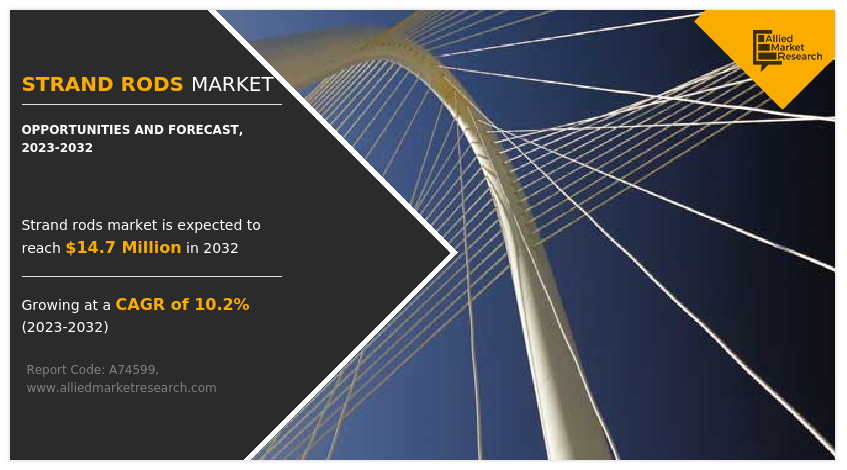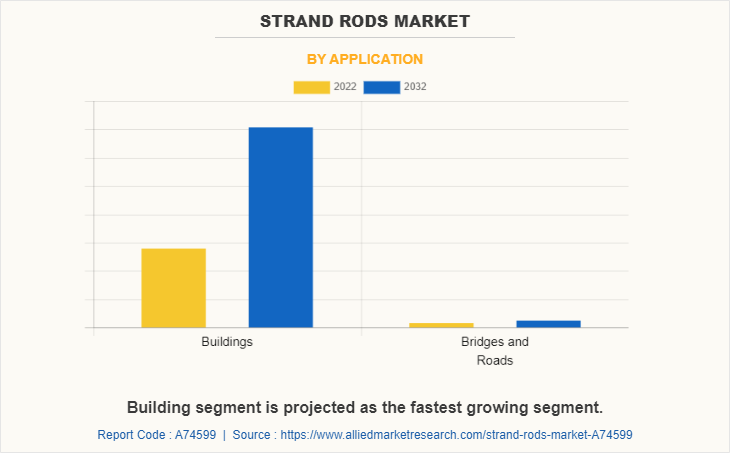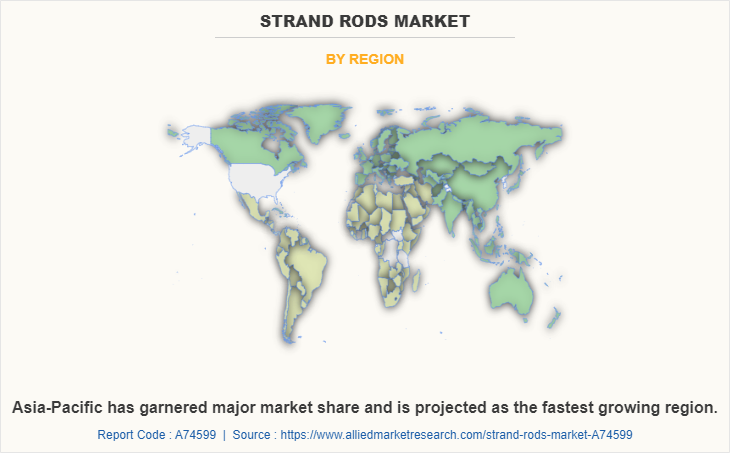Strand Rods Market Research, 2032
The global strand rods market was valued at $5.8 million in 2022, and is projected to reach $14.7 million by 2032, growing at a CAGR of 10.2% from 2023 to 2032.
Key Report Highlighters:
- The report depicts detailed insights into the strand rods market trends and new growth opportunities.
- The report provides a complete analysis of the market status across key regions and more than 15 countries across the globe in terms of value ($ Million)
- The report identifies the strand rod market's emerging applications and regions.

Strand rod is a type of carbon fiber composite material having an exterior layer made of inorganic fiber and a core of carbon fiber that has been impregnated with thermoplastic resin. The use of thermoplastic resin enables the material to be heated again after hardening. The lightweight nature of the strand rods makes them portable. For instance, a roll of strand rod measuring 160 m only weighs 12 kg. The carbon strand rod has a lower weight, great durability, low dimensional change with temperature, and high tensile strength & corrosion resistance.
Carbon fiber strands have many advantageous features. It is aesthetically pleasing along with being the lightest seismic reinforcement in the world. It is very tensile and has a delicate, yet strong structural body. Along with carbon fiber composites, the use of textiles was also taken into consideration for seismic reinforcement of the buildings. This included ‘greenbiz' ultrafine porous spongy ceramic base, which is an eco-friendly building material.
The JEC Group, a nonprofit organization solely dedicated to promoting composite materials and advancing their uses globally, recognized the strand rod as a cutting-edge novel material in 2018. The rod is made of a thermoplastic resin, which allows simple bending and working when heat is applied. This makes it easier to use on construction sites. The feature that makes installation simple fills a significant unmet need in the building and construction sector. Its adaptability for application in seismic force-resisting systems is its key benefit when considering its use as seismic reinforcement. These rods can be used on a variety of structures constructed from various materials, including timber, concrete, masonry, and steel.
Another advantage is the ability of strand rods to be used on projects with the intention of preserving historically important structures. It can be utilized on significant cultural landmarks as it is rust-proof (JEC Group, 2018). It was created with the idea of being applied to already-existing structures. It can be utilized to safeguard historical sites that may not have had their foundations reinforced. Furthermore, carbon fiber strand rods satisfy all of the FEMA (Flood Risk Analysis and Mapping) specifications for the seismic retrofit of existing structures.
Increased seismic activities across the globe - key driver for strand rods market
In 2022, the average disaster-like earthquake occurrence was higher than the past two decades' average. Currently, the National Earthquake Information Centre in the U.S. tracks over 20,000 earthquakes annually, or about 55 per day, around the world. The public now knows about earthquakes more swiftly than ever before thanks to advancements in communications and a rise in interest in natural disasters.
Earthquakes are a naturally occurring phenomenon, vital to the formation and function of our planet. While the quantity of earthquakes has not grown, there has been a rise in the number of disasters brought on by earthquakes, as well as an increasing number of individuals affected by earthquakes. The number of earthquakes caused by humans has increased as a result of activities such as mining, nuclear explosions, and groundwater exploitation. According to the information available, around 728 earthquakes in the previous 149 years may have been caused by human activity.
Moreover, there is less awareness about strand rods compared to other building materials. Strand rods got commercialized in recent years, so there is less awareness about the usability of the product. Once the advantages and usability of strand rods are better known to the consumers, the demand for the product is projected to increase. Owing to some major changes in the earth’s internal surface, the world has experienced some major earthquakes. Now, many researchers are focused on decreasing the impact of seismic waves on structures. This may increase the demand for strand rods during the forecast period.
Earthquakes are an indication of the transformation of the earth’s internal surface. The reduction of the effect of seismic waves on structures has been the subject of numerous scientific investigations. Many passive solutions that are centered on reducing the lateral loads on structures were initially created for this purpose to lessen the damage brought on by earthquakes.
However, from the latter part of the 20th century, attention has switched to the introduction of active earthquake procedures designed to absorb seismic waves or prevent the waves from passing through the building. Even though an earthquake cannot be prevented, the least that can be done to lessen the damage is to make the buildings more earthquake-resistant, using modern earthquake-resistant technology. And strand rod is the best suitable option to make a building earthquake resistant by providing seismic reinforcement.
The strand rods market is segmented into application and region. On the basis of application, the market is bifurcated into buildings and bridges & roads. Region-wise the market is studied across North America, Europe, Asia-Pacific, and LAMEA.
KOMATSU MATERE Co.,Ltd. is the only company manufacturing strand rods. Major suppliers of the raw materials operating in the global strand rods market include Hexcel Corporation, TEIJIN LIMITED, Formosa Plastics Corporation, SGL Carbon, Nippon Kokuen Group, Mitsubishi Chemical Corporation, DowAksa, TORAY INDUSTRIES, INC., and Solvay S.A.

One of the engineering applications of composite strand rods is the seismic reinforcement of buildings. Strand rods can be applied both inside and outside to produce seismic reinforcement. By offering a different route for the forces to be conveyed to the ground, they assist in reducing the stress exerted on a building when a seismic event does occur. To ensure the rods' efficiency, it is crucial that they are installed and set correctly. In addition, the application configuration allows the strand rods to be readjusted and tightened.
In addition, Strand rods are also used in shear walls which offer sufficient rigidity and strength to limit lateral displacements during the event. Typically, shear walls can cause problems in coordinating with facade design. The use of strand rods in a shear wall is beneficial as it is less bulky than a typical shear wall and provides visibility through the member, which still allows for a more open feel in the space.

Earthquake risk in Asia is extremely varied and depends on the tectonic setting within each individual country. The highest hazard areas are either located near plate borders, such as northern India and southwestern China, or beneath subduction zones, such as Indonesia, the Philippines, Japan, Guam, and New Zealand. In addition, the construction industry in the Asia-Pacific region is growing at a rapid pace. The growth in the construction industry coupled with the surge in seismic activities in the region is expected to foster the demand for seismic reinforcement of the buildings, thus driving the demand for strand rods.
The countries with the highest rate of earthquakes are anticipated to see high demand for strand rods. Earthquakes are among the deadliest of natural disasters, and Asia-Pacific hosts the two most seismically active fault lines stretching thousands of kilometers across many national borders.
The highest risk is in the Pacific ‘Ring of Fire,’ where tectonic plate movements create around 90% of the world’s earthquakes. These fault lines threaten many countries, of which the most populous are Japan, the Philippines, and Indonesia. These factors are driving the demand for strand rods in Japan, The Philippines, and Indonesia.
Key Benefits For Stakeholders
- This report provides a quantitative analysis of the market segments, current trends, estimations, and dynamics of the strand rods market analysis from 2022 to 2032 to identify the prevailing strand rods market opportunities.
- The market research is offered along with information related to key drivers, restraints, and opportunities.
- Porter's five forces analysis highlights the potency of buyers and suppliers to enable stakeholders make profit-oriented business decisions and strengthen their supplier-buyer network.
- In-depth analysis of the strand rods market segmentation assists to determine the prevailing market opportunities.
- Major countries in each region are mapped according to their revenue contribution to the global market.
- Market player positioning facilitates benchmarking and provides a clear understanding of the present position of the market players.
- The report includes the analysis of the regional as well as global strand rods market trends, key players, market segments, application areas, and market growth strategies.
Strand Rods Market Report Highlights
| Aspects | Details |
| Market Size By 2032 | USD 14.7 million |
| Growth Rate | CAGR of 10.2% |
| Forecast period | 2022 - 2032 |
| Report Pages | 250 |
| By Application |
|
| By Region |
|
| Key Market Players | Hexcel Corporation, DowAksa, Nippon Kokuen Group, TEIJIN LIMITED, TORAY INDUSTRIES, INC., KOMATSU MATERE Co.,Ltd., SGL Carbon, Solvay S.A., Formosa Plastics Corporation, Mitsubishi Chemical Corporation |
Analyst Review
According to the opinions of various CXOs of leading companies, an increase in seismic activities across the globe drives the demand for strand rods. Rise in awareness of the impact of earthquakes on a building and its effect on people are the factors that boost the demand for strand rods. However, the lesser-known application and useability of strand rods hinder market growth.
The growing need for seismic reinforcement of buildings is the upcoming trend in the strand rod market.
The building segment is the leading application of the strand rod market.
Asia-Pacific is the largest regional market strand rod.
The global strand rods market was valued at $5.8 million in 2022, and is projected to reach $14.7 million by 2032, growing at a CAGR of 10.2% from 2023 to 2032.
KOMATSU MATERE Co., Ltd. is the only company manufacturing strand rods. Major suppliers of the raw materials operating in the global strand rods market include Hexcel Corporation, TEIJIN LIMITED, Formosa Plastics Corporation, SGL Carbon, Nippon Kokuen Group, Mitsubishi Chemical Corporation, DowAksa, TORAY INDUSTRIES, INC., and Solvay S.A.
Loading Table Of Content...
Loading Research Methodology...



